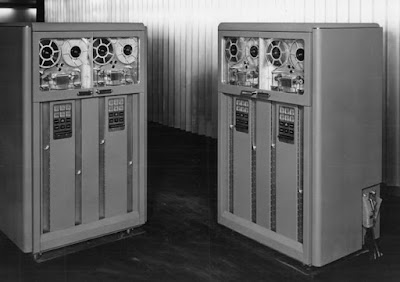If
you are currently a graduate student or have been out for sometime, let’s see
if you can guess when I was in graduate school. All my graphics and maps were
created with Rapidograph pens with different tip sizes, lettering stencils, and
rub-on letters and numbers.
 |
| Koh-I-Noor Rapidograph. Source |
 |
|
PrestoTM
Rub-on Letters and Numbers. Source.
|
I
had a Texas Instruments handheld calculator. For data analysis, I used programmable
calculators that were secured to benches in the statistics department.
I
learned computer programming on a mainframe IBM 370 Model 155 with
the FORTRAN language.
 |
| IBM 370 Model 155 public domain Source. |
Data
were entered manually on punched cards. The sound of punch machine room was
deafening. Wish I had those Bose noise deafening headphones for the many days I spent punching data on Hollerith cards.
 |
| Used Hollerith punch card. Pete Birkinshaw from Manchester, UK • CC BY 2.0 |
 |
| Classic computer keyboard: The IBM 029 Keypunch source |
 |
| 4.5 megs of data on 62,500 punch cards in 1955. Source. |
Starting
a program meant either carrying your card deck or tape to another building
where the computer was likely in a basement room and submitting to a computer
operator. Or you could use a terminal, such as the Decwriter, a line printer
terminal. Yes, we would communicate with the computer one line at a time!
 |
| A DEC LA36 DECwriter II Terminal Source. |
Magnetic tape drives were standard parts of mainframe
computers through the 1980s. The nine-track
tapes (10.5 inch reel) developed by IBM for its computers could store up to 175
MB per tape.
 |
| IBM tape drives. Source. |
Data
manipulation and analysis was with SAS.
I learned SAS 76. This was pronounced
“sass,” never “Ess Ayy Ess”. SAS was an acronym for “Statistical Analysis System, which was developed in 1966 with a
grant from the National Institutes of Health (NIH) to 8 land-grant
universities to analyze agricultural data. SAS was taken private in 1976, and
henceforth called “SAS Institute, Inc”. In 1976, Base SAS consisted of ~
300,000 lines of code. A SAS program was
written on punch cards, in a language similar to PL/I. Semicolons were required at the end of each
line. If you left one out, the program failed and you ran back to the punch card room to fit your error. And PROC statements were and rigid syntax were required.
I
learned fish population dynamics with my TI-30, FORTRAN and BASIC programs. Imagine how disruptive my teaching was which
had students play fishery simulation games on the computer (Li and Adams 1976).
My first personal desktop computer was an Apple II. was one of the first
computer with a color display, and it has the BASIC programming language
built-in, so it is ready to run right out of the box. I never used a
spreadsheet in graduate school VisiCalc,
a spreadsheet, was the first killer app for the Apple II. https://en.m.wikipedia.org/wiki/VisiCalc Lotus 123 was released later. https://en.m.wikipedia.org/wiki/Lotus_1-2-3
I
typed my thesis and dissertation on an IBM Selectric electric typewriter. Even
all equations with subscripts and superscript and special mathematical
operations. I never had email in graduate school. We used snail mail to submit applications and multiple copies of manuscripts. The first email I had was in early 1980. Orth@bitnet. net was my address. BITNET was the precurser to the world wide web and file sharing was done with ftp and Gopher.
 |
| One equation from Master’s Thesis (Orth 1977) |
I didn't think it was difficult at the time. I simply didn't know of any other options. I received my PhD in 1980.
References
Li, H.W., and P.B.
Adams.1976. Three computer simulation games for the instruction of fish
population dynamics. Fisheries 1(1):22. https://swfsc.noaa.gov/publications/CR/1976/7626.PDF
Orth,
1977. Development of a computer simulation model of largemouth bass population
dynamics. Master’s Thesis, Oklahoma State
University, Stillwater. https://shareok.org/bitstream/handle/11244/19142/Thesis-1977-O77d.pdf






No comments:
Post a Comment